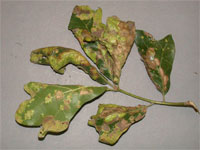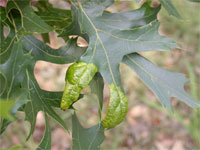Download PDF (PLPA-101)
This disease occurs on many species of oak and is one of the major diseases on oak trees in Texas.
CAUSAL AGENT
Taphrina caerulescens (fungus)
Spores of the fungus overwinter on the bud scales and infect emerging leaves when conditions are conducive to disease development.
ENVIRONMENTAL CONDITIONS
Oak leaf blister is favored by cool and moist conditions during budbreak and early stages of leaf development. Infections occur when leaves are emerging. Expanded (older) leaves are not susceptible.
 SYMPTOMS
SYMPTOMS
Abnormal growth of leaf includes bulges, depressions, cupping and twisting. Numerous blisters can coalesce to affect entire leaf. Bulges are usually light green, eventually turning to brown as the leaf ages. Defoliation can occur on severely diseased trees. Often leaves remain on tree.
MANAGEMENT
This disease does not seriously affect the overall health of the tree. The aesthetic value of the tree is diminished by diseased leaves that remain on the tree. Chemical controls are usually not recommended. Once infection has occurred, chemical treatments are ineffective.
Fungicide, such as mancozeb or chlorothalonil, can be used as protectants. Preventative fungicide should be applied just prior to budbreak and through early leaf development for effective control.
Sanitation – removal of infected leaves from areas around the tree will help some to minimize inoculum levels.
Prepared by Dr. Kevin Ong
Assistant Professor and Extension Urban Plant Pathologist
Texas AgriLife Extension Service; The Texas A&M University System
May 5, 2002 (rev. 032508)
The information given herein is for educational purposes only. References to commercial products or trade names are made with the understanding that no discrimination is intended and no endorsement by Texas AgriLife Extension Service personnel is implied.
Educational programs of the Texas AgriLife Extension Service are open to all people without regard to race, color, sex, disability, religion, age, or national origin.
The Texas A&M University System, U.S. Department of Agriculture, and the County Commissioners Courts of Texas Cooperating